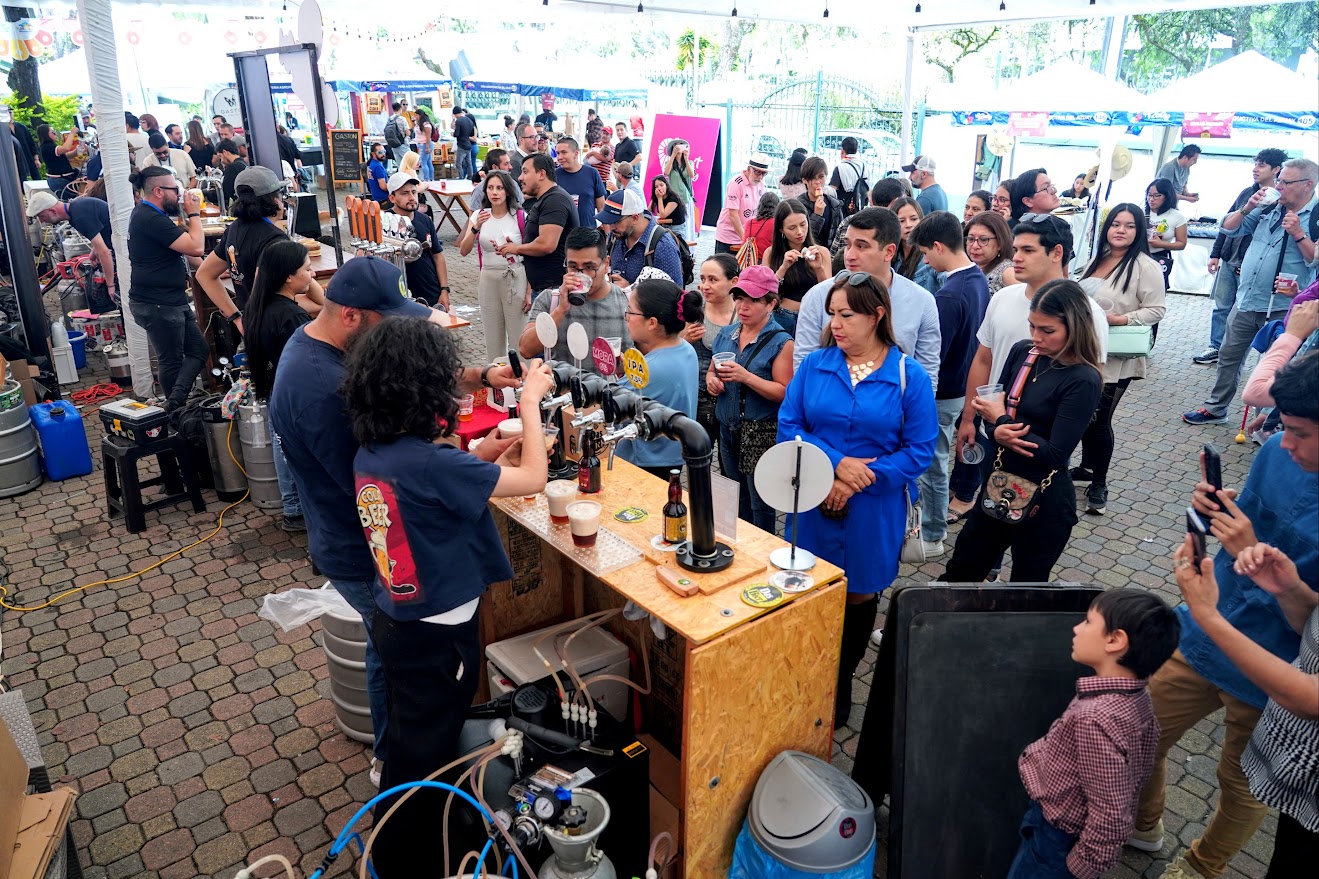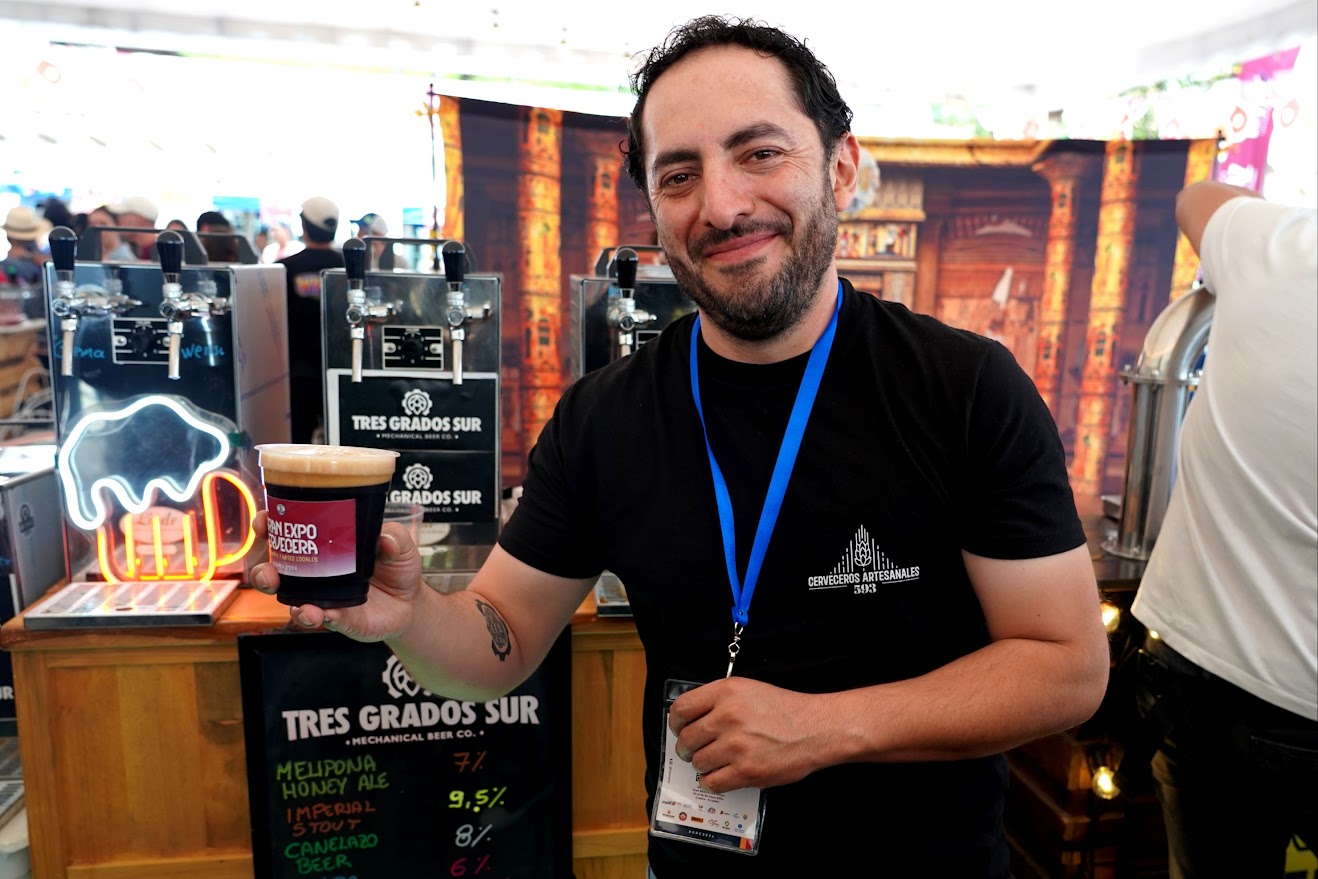Ecuador’s craft beer brewers challenge the beer conglomerates, showcase their brands in Cuenca

Vilcabamba’s Sold del Venado will ship you a dozen of their beers for $30 plus shipping to anywhere in Ecuador.
By Stephen Vargha
It’s like the biblical David versus Goliath.
For the craft beer industry in Ecuador, it is them versus AB InBev, the brewing company based in Leuven, Belgium.

Cuenca’s Asiringui Cerveza Artesanal offers its beers in bottles. They are one of the few offering sour beers in Ecuador. Santa Rosa Cerveza Artesanal, in Quito, has a fruited Berliner Weisse.
AB InBev has a fourth of the world’s global sales, taking in $59 billion for its last fiscal year. The brewing giant’s mass-produced beers include Budweiser, Stella Artois, Corona, Pilsener, and Club.
Other brewing giants make it difficult for the small craft brewers.
Based in Amsterdam, Heineken is the No. 2 brewer in the world and No. 1 in Europe.

People of all backgrounds and ages were happy with the craft beers they tasted at the festival.
Headquartered in Hong Kong, China Resources Snow Breweries has the third highest global market share. One of its flagship beer brands, Snow, is now one of the top-selling beer brands in the world.
Founded in 1847 in Copenhagen, Denmark, Carlsberg is one of the leading international brewery groups in the world today.
Merged into a new company in 2003, Molson Coors is fifth in global sales with 31 breweries.

Many Ecuadorians turned out for the beer festival. Craft brewers say IPAs are preferred by many Ecuadorians.
And Tsingtao Beer, one of China’s oldest beer companies, has been successful in establishing a high-end beer brand image. Having sold its beer for 115 years, it is No. 6 in the world.
This past weekend, 13 craft breweries took their slingshot and beer to Cuenca to battle the giant brewing company at Experiencia Maridaje GRC 2024. The craft beer festival was held this past weekend on the grounds of CIDAP.
“There’s not a lot of beer culture in Cuenca,” said David Gonzalez. “We are trying to gain some spaces.”
Gonzalez is the 34-year-old brewer and co-owner of Cuenca’s Tagui Cerveza Artesanal along with his twin brother, Santiago.
Like many craft brewers in the United States, the brothers started out on a different career path. The brewing process, intricate and complex, is perfect for engineers to apply their expertise.

Club is just one of the mass-produced beers AB InBev makes.
Craft brewing demands a blend of technical know-how and creativity. David started out as an electrical engineer while Santiago was an environmental engineer. Now, they are applying their knowledge to quality beer.
“We really like beer. It started as a hobby at my mother’s home,” said David. “Three years ago, when my sister got married, she wanted our beer for her wedding. There were about 60 people and they all liked it. That was our beginning.”
Beer is consumed in about 195 countries, according to the United Nations’ Food and Agriculture Organization. Only 14 nations do not consume beer as alcohol consumption isn’t allowed.
“We are a global culture. What happens in Europe and the United States will happen here,” said David. “We want to bring the flavors of beers to Ecuadorians, and we have great beers that we want Ecuadorians to enjoy.”

Craft brewers were happy to show off their diverse variety of beers.
Tagui Cerveza Artesanal currently has taps in four restaurants in Cuenca, with bottles in several others.
“They say our beer is so delicious and suave,” said Katherine Tixi.
Tixi, 32 years old, is the co-founder of Riobamba’s Nefer Cervecería Artesanal along with Bladimir E. Urgilés Rodríguez, who is the brewmaster.
“We are seeing a lot more Ecuadorians craft beer,” said Tixi. “Our doppelbock beer is very popular.”
Originally made by monks in Munich, Germany, Doppelbock is a stronger version of a German-style bock beer. One can expect higher ABV (alcohol by volume) and more intense flavors.

Saturday’s attendance was huge for the craft beers festival on the grounds of CIDAP.
Out of all beer types, lager is the most popular type of beer throughout the world. Refreshing and crisp, it is bottom-fermented and brewed to an ABV between five and 11 percent. Usually, it is at the lower end.
Worldwide, ales are probably the second most popular. Yeast ferments at a warmer temperature and then settles at the top of the drink. Ale can be made in just seven days, making it easy for craft breweries that have limited space and a small number of fermentation tanks.
“Pagano IPA is 60 percent of our sales,” said Ricardo Castañeda, the founder of Quito’s Pagano Beer Company. “Ecuadorians love IPA. They don’t like it very bitter.”

Cuenca’s Tagui Cerveza Artesanal currently has taps in four restaurants in the city, with bottles in several others.
Their IPA is described as having “strong citrus and tropical tones of grapefruit, melon, lime, gooseberry, passion fruit and lychee notes with a nice dry and smooth finish.”
It has an IBU (International Bitterness Units) of 45. IBU measures the parts per million of isohumulone from hops, which gives beer its bitterness. The IBU scale starts at zero and goes all the way up to about 120.
The popular craft beer app, Untappd, has tough graders. Pagano’s IPA has a very respectful 3.74 out of five stars from people who have drunk the beer.
“IPA is our most popular beer,” said Jorge Peralta. “Ecuadorians really like it.” It has an IBU of 52.
Peralta is the founder of Cuenca’s three-year-old Asiringui Cerveza Artesanal.

There many varieties of craft beers to choose from at this past weekend’s festival.
“We love beer and instead of being just consumers we decided to become producers,” said Peralta. “We have a 100 percent artisanal product with the best ingredients.”
That love has produced a blueberry sour beer.
“We started making it in January,” said Peralta. “We deliver it in bottles.”
As its name suggests, sour beer has a definite sour, acidic, or tart taste. Before there were refrigerators, almost all beer was, to varying degrees, sour.
Often naturally occurring bacteria including Lactobacillus and Pediococcus, as well as Brettanomyces (literally means British fungus) yeasts, gave the 19th century beers a hint of tartness and funky flavors as well as aromas. Now, brewers know how to avoid that sourness.
But today, beers are produced on purpose, with the bacteria that makes it sour. In the United States, sour beers have become a popular style, especially among the younger generations.
Asiringui Cerveza Artesanal has one of the only sour beers in Ecuador. On Plaza de San Sebastián, Jodoco Belgian Bistro has one too.

Canelazo is Loja’s Tres Grados Sur Cervecería Artesanal No. 1 beer. They produce traditional beers, including honey ale.
“Canelazo is our No. 1 beer,” said Dario Orellana. “It is a traditional drink in Ecuador, so Ecuadorians love our Canelazo beer.”
Orellana founded Tres Grados Sur Cervecería Artesanal almost four years ago in Loja. He produces traditional beers, including honey ale. The honey is from Loja province. When Ecuadorians have his beers for the first time, the reactions are positive.
“People love it when they taste our beers,” said Orellana. “Craft beers are becoming more popular.”
Not all craft breweries in Ecuador are owned by Ecuadorians. A native of San Diego, Curtis Hofmann founded Sol del Venado, in Vilcabamba.
“In 2012, I brought a container with my household goods and commercial brewing equipment,” said Hofmann. “Pure water from the mountains and from our property are an important part of our beers.”
Sol del Venado’s IPA is the most popular among expats. For Ecuadorians, yellow and red lagers are the most popular. “They are beginning to like IPA,” said Hofmann.
The Vilcabamba brewery sells directly to the consumer. One does not have to drive five hours south to get their beers.
For $30, they will ship cheaply a dozen of their craft beers directly to your home in Ecuador. The dozen can be a mix-and-match of their six styles of beers.
Around 4000 BCE, the Sumerians enjoyed this alcoholic beverage that is considered the oldest in the world. It remains popular, ranking third in global beverage consumption after water and tea.
And Ecuadorian craft brewers are aiming to make their beers No. 1 in Ecuador, especially Cuenca.
“Craft beer is growing in Quito. The market is there,” said Castañeda. “Here in Cuenca, it is just starting; it will explode soon.”
_________________
Asiringui Cerveza Artesanal, Calle de las Hiedras y Av. Ordoñez Lasso, Cuenca 010107, 099-998-0412, https://www.facebook.com/AsiringuiCerveza
Jodoco Belgian Bistro, Plaza de San Sebastián, Cuenca, 097-909-3186, https://jodocobelgianbistro.com
Nefer Cervecería Artesanal, Riobamba 060104, 098-766-9916, https://cervecerianefer.com
Pagano Beer Company, Quito, paganobeerco@gmail.com, https://www.facebook.com/paganobeerco
Sol del Venado, Vilcabamba, 098-224,5678, 07 264 0121, +1 760.936.9398, curtis@soldelvenado.com, https://www.facebook.com/SoldeVenado
Tagui Cerveza Artesanal, De las Hiedras, Cuenca, https://www.facebook.com/taguicervezaartesanal/?locale=es_L
Tres Grados Sur Cervecería Artesanal, Loja 110108, 099-223-6143, https://www.tresgradossur.com
Untappd, https://untappd.com/
Photos by Stephen Vargha
Stephen Vargha’s book about Cuenca, “Una Nueva Vida – A New Life” is available at Amazon in digital and paperback formats. His award-winning blog, “Becoming Cuenca,” supplements his book with the latest information and hundreds of professional photos by him.





















